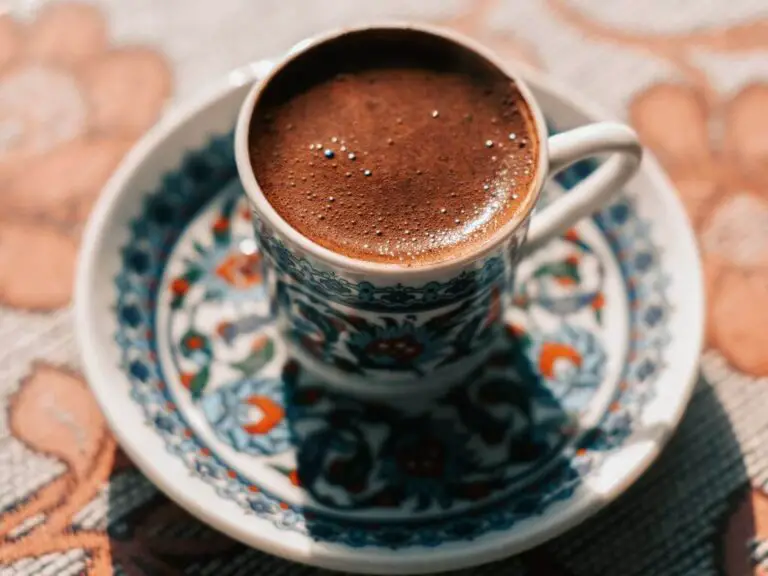Greek Coffee vs Turkish Coffee: What’s the Difference?
Coffee isn’t just a drink—it’s culture, tradition, and history in a cup. If you’ve ever wondered “what’s the difference between Greek coffee and Turkish coffee?” — or typed “greek coffee vs turkish coffee” into search — you’re in the right place.
Both drinks look very similar: finely ground coffee, brewed slowly in a small long-handled pot, and served in tiny cups. Yet each has its own names, rituals, and tiny flavor cues that make the experience special. In this article (step-by-step), we’ll explore the origins, the brewing ritual, the taste and foam, serving traditions, and which one you might like best.
What you’ll get from the next sections:
- ✅ Clear, friendly explanations (easy words)
- ✅ A simple comparison you can skim
- ✅ Practical tips to try them at home
- ✅ Cultural notes and little traditions that make each cup memorable ☺️

History & Origins
Greek coffee and Turkish coffee share a long, intertwined past. Their story travels back through the Ottoman Empire and into village kitchens, city cafés, and family gatherings across the eastern Mediterranean.
Quick history highlights
- Origins: The brewing style became popular across the Ottoman Empire (roughly from the 16th century onward). As the beverage spread, different regions made it their own.
- Names & identity: In Turkey the drink is called “Türk kahvesi” (Turkish coffee). In Greece you’ll hear “Greek coffee” or ellinikó kafé. Both countries claim strong cultural ties to the drink — and both are right: the cup is part of each nation’s living tradition.
- Coffeehouses: Early coffeehouses in cities like Istanbul and Athens turned coffee into social life — places for conversation, games, and news. That social role still matters today.
At-a-glance origins table
| Feature | Greek Coffee | Turkish Coffee |
|---|---|---|
| Local name | Greek coffee (ellinikó) | Türk kahvesi |
| Traditional pot | Briki | Cezve / Ibrik |
| Cultural roots | Ottoman-era influence; Greek adaptations | Ottoman core tradition; national standard in Turkey |
| Social role | Everyday coffee, hospitality, small talk | Coffeehouses, hospitality, ceremonies |

Brewing Method: The Ritual Behind the Cup 🫖✨
Brewing Greek coffee vs Turkish coffee is more than just pouring hot water over grounds. It’s a small, patient ritual — one that brings out rich aroma, thick foam, and centuries of tradition in every sip. Let’s break it down.
Equipment & Ingredients
Both drinks are prepared using a small long-handled pot and finely ground coffee, but the names and subtle styles differ:
| Feature | Greek Coffee | Turkish Coffee |
|---|---|---|
| Brewing pot | Briki | Cezve/Ibrik |
| Coffee grind | Extra fine, almost powdery | Extra fine, almost powdery |
| Water | Cold, filtered | Cold, filtered |
| Sugar | Added before brewing (optional) | Added before brewing (optional) |
| Optional extras | Cardamom (rare) | Cardamom often added |
Step-by-Step Brewing
- Measure water: Use one demitasse cup of cold water per serving.
- Add coffee: 1–2 teaspoons per cup. Don’t stir yet!
- Add sugar (optional): Choose your sweetness:
- Greek: Sketos (no sugar), Metrios (medium), Glykos (sweet)
- Turkish: Sade (no sugar), Orta (medium), Şekerli (sweet)
- Mix gently: Stir before heating to combine coffee, water, and sugar.
- Simmer slowly: Place the briki/cezve over low heat. Slow heating is key — never boil.
- Foam formation: Watch as a thick foam forms on top.
- Greek: Kaimaki
- Turkish: Köpük
- Remove just before it boils: Pour gently into small cups, keeping the foam intact.
💡 Tip: For the perfect cup, avoid stirring after pouring. The fine coffee grounds settle at the bottom — that’s part of the authentic experience.
Serving Style & Traditions 🍬💧
Drinking Greek coffee vs Turkish coffee isn’t just about taste — it’s about the ritual, the company, and the little extras that make the experience special. Let’s see how each culture enjoys its cup.
Serving Basics
- Cup size: Both are served in small demitasse cups (about 2–3 oz / 60–90 ml).
- Glass of water: Always served on the side to cleanse the palate before sipping.
- Sweet accompaniments:
- Greek coffee → Loukoumi (Greek delight) or a small biscuit.
- Turkish coffee → Turkish delight (lokum).
Quick Serving Comparison
| Feature | Greek Coffee | Turkish Coffee |
|---|---|---|
| Cup | Demitasse | Demitasse |
| Water | Served on side | Served on side |
| Sweet treats | Loukoumi or biscuit | Turkish delight (lokum) |
| Rituals | Family gatherings, chatting | Social gatherings, fortune-telling |
| Pace | Sip slowly | Sip slowly |
☕ Fun fact: The small cup is deliberate — it keeps the coffee hot and helps you enjoy intense flavors in small sips.

Taste & Texture: What’s Inside the Cup? 😋
When it comes to Greek coffee vs Turkish coffee, the magic is in the flavor, aroma, and the silky texture that makes each sip memorable. Let’s explore what your taste buds can expect.
Similarities
Both drinks share a lot in common:
- Strong & bold flavor – one small cup delivers a punch of coffee intensity.
- Thick body – unfiltered, with fine coffee grounds that settle at the bottom.
- Aromatic experience – the slow brewing releases rich, nutty, and slightly earthy aromas.
- No milk – traditionally served black, highlighting the pure coffee taste.
Differences
Even though they look similar, subtle differences set them apart:
| Feature | Greek Coffee | Turkish Coffee |
|---|---|---|
| Roast preference | Usually lighter roast, slightly sweeter taste | Medium to dark roast, bolder and more robust |
| Foam | Kaimaki – creamy, delicate | Köpük – slightly denser, strong aroma |
| Aftertaste | Mildly sweet, smooth | Rich, slightly stronger bitterness |
| Sediment | Fine grounds settle | Fine grounds settle (don’t stir!) |
Sweetness Levels & Customization 🍯
One of the unique things about Greek coffee vs Turkish coffee is that sweetness is decided before brewing, not after. This might feel unusual if you’re used to adding sugar to your cup later, but it’s key to achieving the perfect balance.
How Sugar is Added
- Sugar is mixed with the coffee and water in the pot before heating.
- This allows the sweetness to infuse evenly while brewing.
Typical Sweetness Levels
| Sweetness | Greek Coffee | Turkish Coffee |
|---|---|---|
| No sugar | Sketos | Sade |
| Medium | Metrios | Orta |
| Sweet | Glykos | Şekerli |
💡 Tip: Start with medium sweetness if you’re unsure — you can always adjust next time.
Customization Options
- Spices: Some people add cardamom (common in Turkish coffee) or a hint of cinnamon (in Greece).
- Serving style: Pair with your favorite sweet treat for an authentic experience:
- Greek coffee → Loukoumi, honeyed biscuits, or a small pastry.
- Turkish coffee → Turkish delight (lokum), baklava, or chocolate.
Health Benefits & Caffeine Content 💪☕
Beyond flavor and culture, Greek coffee vs Turkish coffee offers some surprising health perks, especially since both are unfiltered coffees. Let’s break it down.
Health Benefits
- Rich in antioxidants 🟢
- Helps fight free radicals, which can reduce inflammation and oxidative stress.
- Supports heart health ❤️
- Moderate consumption has been linked to improved cardiovascular function.
- Aids digestion 🍽️
- Traditionally enjoyed after meals, it can help stimulate digestion.
- Mental alertness 🧠
- Natural caffeine boost enhances focus and energy.
⚠️ Tip: Enjoy in moderation — about 1–2 small cups per day is enough to reap benefits without overdoing caffeine.
Caffeine Comparison
| Feature | Greek Coffee | Turkish Coffee |
|---|---|---|
| Caffeine content | Moderate (~40–60 mg per small cup) | Moderate (~50–65 mg per small cup) |
| Strength | Slightly smoother | Slightly bolder |
| Serving size | Small demitasse | Small demitasse |
💡 Note: Both drinks have similar caffeine levels, but the perception of strength can differ based on roast and brewing style.
Key Differences at a Glance ✅
Sometimes you just want the quick answer: what makes Greek coffee vs Turkish coffee different? Here’s a handy table to compare the main features side by side.
| Feature | Greek Coffee ☕🇬🇷 | Turkish Coffee ☕🇹🇷 |
|---|---|---|
| Brewing pot | Briki | Cezve/Ibrik |
| Roast | Usually lighter | Medium to dark |
| Foam | Kaimaki – delicate | Köpük – denser |
| Sweet pairings | Loukoumi, biscuits | Turkish delight (lokum) |
| Serving style | With water, slow sipping | With water, slow sipping |
| Fortune telling | Common | Common |
| Taste | Smooth, mildly sweet | Bold, richer flavor |
| Cultural context | Family & social gatherings | Coffeehouses & social rituals |
📌 Quick tip: If you want a lighter, smoother experience, go Greek. If you crave stronger, bolder coffee, try Turkish.
Which One Should You Try? 😋
So, after exploring Greek coffee vs Turkish coffee, you might be wondering: which one should you pick for your next cup? Here’s a friendly guide to help you decide.
Choosing Based on Flavor
- Greek Coffee ☕🇬🇷
- Lighter roast, smoother taste
- Less bitter, slightly sweet aroma
- Perfect if you enjoy a gentler coffee experience
- Turkish Coffee ☕🇹🇷
- Medium to dark roast, bolder flavor
- Strong aroma and richer aftertaste
- Ideal if you prefer a robust, intense coffee
How to Enjoy It Authentically
- Serve with a sweet treat
- Greek coffee → loukoumi, honeyed biscuits, or pastries
- Turkish coffee → Turkish delight (lokum) or a small dessert
- Sip slowly to appreciate the foam and texture
- Accompany with a glass of water to cleanse your palate
Conclusion — The Final Sip ☕✨
Whether you choose Greek coffee vs Turkish coffee, one thing is certain: you’re not just drinking coffee, you’re sipping centuries of culture, tradition, and social ritual in every tiny cup.
Both drinks share similarities — the small demitasse cup, the rich foam, the fine grounds at the bottom — yet each has its own personality:
- Greek coffee is smooth, lightly roasted, and subtly sweet.
- Turkish coffee is bold, robust, and rich in aroma.
FAQ’s
Is Greek coffee the healthiest coffee?
Greek coffee is packed with antioxidants and may boost heart health, making it one of the healthiest ways to brew your cup.
What does Greek coffee taste like?
Greek coffee is strong and rich, with a uniquely thick, silty texture and a deep, earthy flavor that is often sweetened during brewing.
Is Greek coffee like Arabic coffee?
While very similar in strength and preparation, Greek coffee is typically made with a lighter roast and is served with the grounds in the cup, whereas Arabic coffee can have cardamom and is often spiced.







